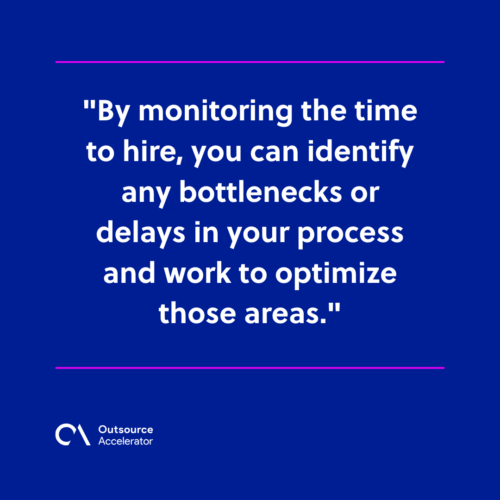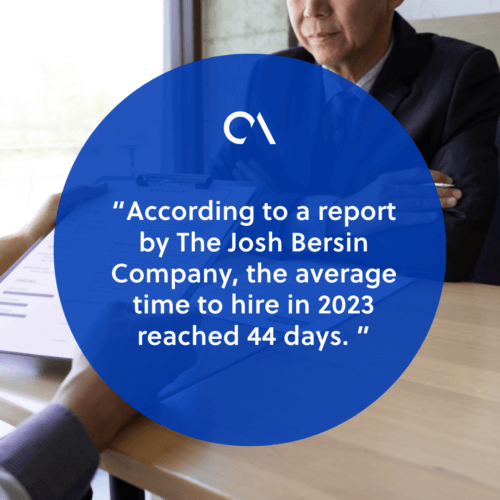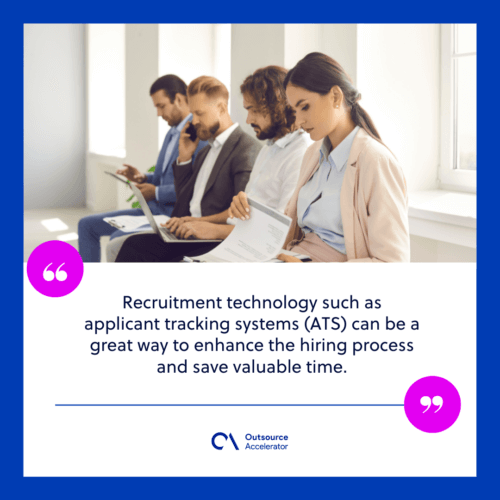Time to hire: What you need to know

As an employer, time is valuable when hiring candidates. You might lose good candidates if hiring employees takes too long on your part.
Studies state that 54% of candidates walk away from a recruitment process due to poor communication from employers. The lengthy hiring process, along with the time it takes to reach out to applicants, may contribute to them losing interest in a job offer.
Looking at your time to hire is a good way to see whether your recruitment process is still effective according to its duration.
What is time to hire?
Simply put, time to hire is the length of time it takes for a candidate to be hired from the moment they apply for a job.
This metric can tell you a lot about the effectiveness of your hiring strategy, from rank and file to even leadership hiring.
By monitoring the time to hire, you can identify any bottlenecks or delays in your process and work to optimize those areas.

Why should you measure time to hire?
Measuring the time to hire can provide these key benefits:
- Tracking this metric can help you identify inefficiencies in your hiring process and highlight areas for improvement.
- Monitoring the time to hire can help you improve your chances of hiring top talent.
The quicker you can find and hire quality candidates, the more competitive your organization will be.
Time to hire vs. Time to fill
It’s important to note that time to hire is not the same as the time to fill.
Time to fill refers to the amount of time it takes to fill a job opening from the point at which it was created. Depending on the company’s practice, it may start from the approval of a job request to the applicant’s first day.
Meanwhile, time to hire measures the duration from when a candidate entered the hiring process to the time they were actually hired.
Average time to hire
The average time to hire can vary significantly depending on the industry, job role, and location. However, research highlights the increasing difficulty for employers to hire staff nowadays.
According to a report by The Josh Bersin Company, the average time to hire in 2023 reached 44 days. Energy and defense companies even take up to 67 days to hire an applicant.
That being said, it’s important to note that a healthy balance must be maintained between quick hiring and choosing the right candidate.
In trying to beat the competition with a faster time to hire, you don’t want to risk compromising the quality of your hiring decisions.

How to calculate the time to hire
Essentially, computing time to hire involves measuring the number of days between when a candidate applies for a job and when they are hired.
Here’s how to do it:
1. Determine the start date. The start date is when the job opening is officially posted on your website or other job search platforms.
2. Note the date the candidate applied. This is the date that the candidate initially submitted their application.
3. Calculate the end date. The end date is the date the candidate is officially hired and begins work.
4. Subtract the start date from the end date. This will give you the number of days it took to hire the candidate.
5 ways to improve time to hire
Time to hire is a key metric to consider when optimizing your hiring process. By measuring it and taking actionable steps to improve it, you can save valuable time and resources and end up with the right candidate for the job.
If you find that your time to hire metric is higher than expected, there are several actionable steps you can take to improve it:
1. Structure hiring process
One of the most effective things you can do is to streamline the hiring process. For example, ensure that the job description is accurate, well-written, and includes the necessary qualifications for the role.
2. Improve careers page
Take a look at your company’s careers page. Remember, this webpage is often the first point of contact for job seekers.
Check for your page’s user-friendliness, your job post’s clear description, and the type of candidates you’re looking for.
3. Consider using an ATS
Recruitment technology such as applicant tracking systems (ATS) can be a great way to enhance the hiring process and save valuable time.
An ATS can help manage resumes, streamline the recruitment process, and assist in sorting and selecting candidates based on various criteria.

4. Create compelling listings
Crafting job listings that are clear, compelling, and accurately reflect the job requirements can make a significant difference in the job search pool.
By vividly describing the job and showcasing what makes your company unique, you can quickly attract the perfect candidate.
5. Utilize video interviews
Video interviews can save time by allowing hiring managers to screen candidates more efficiently. It can also provide an additional layer of insight into the potential candidate’s personality and comfort with technology.







 Independent
Independent




